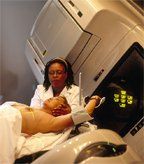ECC: Chest Lymph Node Radiation Improved Survival in Early Breast Cancer
Postoperative irradiation of the internal mammary and medial supraclavicular lymph nodes of patients with early breast cancer resulted in improved survival with no increase in side effects, according to 10-year follow-up results.
Postoperative irradiation of the internal mammary and medial supraclavicular lymph nodes of patients with early breast cancer resulted in an improved overall, disease-free, and metastases-free survival with no increase in side effects, according to 10-year follow-up results presented at the 2013 European Cancer Congress (ECC).

“Our results make it clear that irradiating these lymph nodes give a better patient outcome than giving radiation therapy to the breast/thoracic wall alone,” study author Philip Poortmans, MD, of the Institute Verbeeten, Tilburg, the Netherlands, said during a press conference.
Many centers do not currently irradiate the internal mammary and medial supraclavicular lymph nodes due to concerns about increased toxicity from irradiating such a large area, and the unknown effects of the treatment. However, Poortmans and colleagues believe that the beneficial effect of radiation to these areas can be explained by the ability of the treatment to eradicate microscopic tumor deposits in the lymph nodes.
This study was conducted from 1996 to 2004, during which 4,004 patients were enrolled and randomly assigned to treatment with or without internal mammary and medial supraclavicular (IM-MS) irradiation. Nearly all lymph node–positive and 66.3% of lymph node–negative patients also received adjuvant systemic treatment.
At 10 years follow-up, 429 patients in the no IM-MS arm died from breast cancer compared with 382 in the IM-MS group. All other causes of death were similar between the two groups.
IM-MS treatment results in an improved overall survival with a 10-year overall survival of 82.3% compared with 80.7% in the no–IM-MS arm (HR = 0.87; 95% CI, 0.76–1.00). Although this difference is not statistically significant (P = .0556), after adjustment for stratification factors the P value is .0496, Poortmans said.
In addition, patients who underwent IM-MS radiation also had improved rates of disease-free survival (72.1% vs 69.1%; P = .044) and metastases-free survival (78% vs 75%; P = .02) compared to patients with no IM-MS radiation.
According to the researchers, patients at low risk of their cancer spreading outside the breast will often be given less intensive systemic therapy in order to spare them side effects. In these cases, using IM-MS radiation therapy can improve their outcome by eradicating residual tumor cells in the breast/thoracic wall. For patients at high risk of metastases, who receive systemic therapy, the prospect of cure is also related to the chance of leaving residual tumor cells behind throughout the body. In these cases too, the ultimate outcome can be improved by using effective locoregional treatment to eradicate disease at the site where it is most likely to be present, the researchers said.
“The results of our trial, in which patients received appropriate systemic treatments, contradict the existence of a ‘competition’ between locoregional and systemic treatments,” Poortmans said in a press release. “Because there is an interaction between these treatments, in many patients their combination will result in an enhancement of the combined benefits; in other words, one plus one can equal more than two.”
Newsletter
Stay up to date on recent advances in the multidisciplinary approach to cancer.